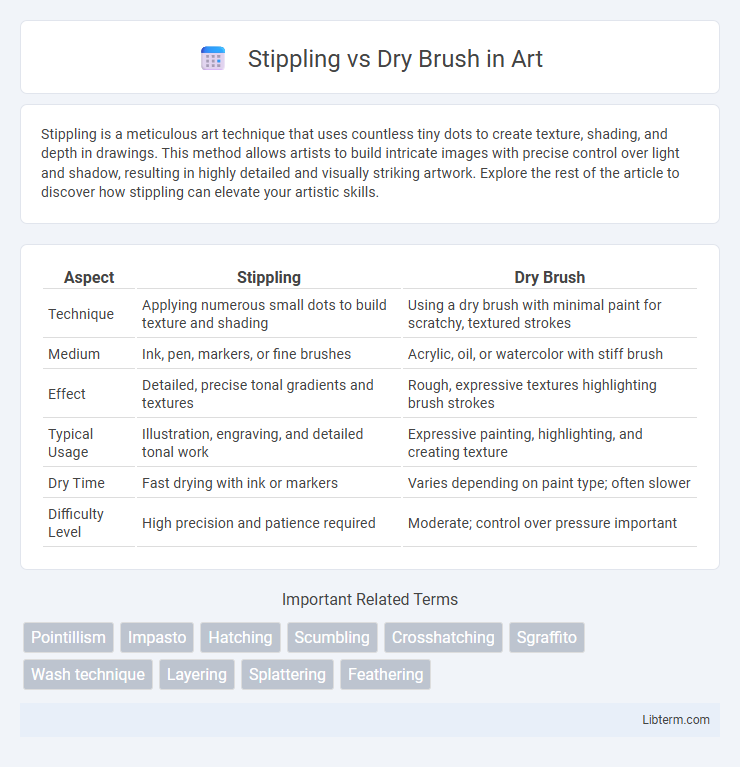Stippling is a meticulous art technique that uses countless tiny dots to create texture, shading, and depth in drawings. This method allows artists to build intricate images with precise control over light and shadow, resulting in highly detailed and visually striking artwork. Explore the rest of the article to discover how stippling can elevate your artistic skills.
Table of Comparison
| Aspect | Stippling | Dry Brush |
|---|---|---|
| Technique | Applying numerous small dots to build texture and shading | Using a dry brush with minimal paint for scratchy, textured strokes |
| Medium | Ink, pen, markers, or fine brushes | Acrylic, oil, or watercolor with stiff brush |
| Effect | Detailed, precise tonal gradients and textures | Rough, expressive textures highlighting brush strokes |
| Typical Usage | Illustration, engraving, and detailed tonal work | Expressive painting, highlighting, and creating texture |
| Dry Time | Fast drying with ink or markers | Varies depending on paint type; often slower |
| Difficulty Level | High precision and patience required | Moderate; control over pressure important |
Introduction to Stippling and Dry Brush Techniques
Stippling and dry brush are two distinct painting techniques used to create texture and depth in artwork. Stippling involves applying small dots or strokes of paint to build up shading and detail, offering precise control and subtle gradients. Dry brush technique uses a brush with minimal paint to produce rough, textured marks, emphasizing highlights and creating a sense of movement and energy in the piece.
What is Stippling?
Stippling is a painting and drawing technique that uses small dots or short dabs of paint or ink to create texture, shading, and depth. Artists apply countless tiny marks in varying densities to build up gradients and intricate details without smooth blending. This method contrasts with techniques like dry brush, which use broader, more sweeping strokes for texture and tone.
What is Dry Brush?
Dry brush is a painting technique where a small amount of paint is applied with a dry, stiff-bristled brush to create textured, scratchy strokes. This method highlights surface details and produces a rough, uneven layer of color that enhances depth and dimension in artwork. Often used in oil and acrylic painting, dry brushing is ideal for adding highlights, fine details, and subtle tonal variations.
Materials Needed for Each Technique
Stippling requires fine-tipped brushes or stippling brushes, acrylic or ink paints, and textured paper or canvas to create precise dot patterns. Dry brush technique utilizes stiff bristle brushes, thick or semi-dry paint with minimal water or medium, and rough surface paper or canvas to achieve textured and scratchy strokes. Both methods demand quality brushes and appropriate surfaces but differ significantly in paint consistency and brush type for optimal execution.
Differences in Application Methods
Stippling involves creating texture and shading by applying small dots or short dabs of paint using a stiff brush or sponge, allowing for controlled buildup of color and intricate detail. Dry brushing requires using a brush with very little paint, applied with light, sweeping strokes to create a soft, textured effect emphasizing surface contours and highlights. The main difference lies in stippling's repetitive dotting technique versus dry brushing's smooth, feathery strokes, each producing distinct visual textures and depth.
Textures and Visual Effects Compared
Stippling creates texture through a series of small dots, producing a grainy, detailed effect ideal for depicting fine patterns and subtle shading. Dry brushing uses a minimal amount of paint on a mostly dry brush to create rough, streaky textures that emphasize brushstrokes and surface irregularities. While stippling offers precision and a controlled build-up of tone, dry brushing provides dynamic, expressive textures that highlight contrasts and depth.
Best Subjects for Stippling vs Dry Brush
Stippling excels at rendering intricate textures and detailed patterns, making it ideal for subjects like foliage, animal fur, and architectural surfaces with fine details. Dry brush suits capturing expressive strokes and rough textures, perfect for weathered wood, fabric folds, and textured skin in portraits. Both techniques highlight different artistic qualities, with stippling emphasizing precision and dry brush focusing on dynamic texture.
Pros and Cons of Stippling
Stippling offers precise texture control, making it ideal for detailed shading and creating a sense of depth in artworks, but it can be time-consuming due to the meticulous dot application. Its granular effect provides a unique tactile quality that differs from the smooth strokes of dry brushing, yet the technique may result in a pointillist appearance that some artists find limiting for broader areas. While stippling excels in monochromatic and subtle gradient work, it lacks the fluidity and speed of dry brush for expressive, dynamic scenes.
Pros and Cons of Dry Brush
Dry brushing offers precise texture control and highlights raised surfaces effectively, making it ideal for adding subtle details to paintings and models. However, it can be challenging to master due to uneven paint application and potential streakiness if the brush is overloaded or too dry. This technique requires careful brush loading and practice to achieve smooth gradients and desired effects without damaging the artwork's finer details.
Choosing the Right Technique for Your Artwork
Stippling uses small dots to create texture and depth, ideal for detailed and controlled shading, while dry brush involves dragging a nearly dry brush over the surface to produce a rough, textured effect suitable for expressive and dynamic strokes. Choosing the right technique depends on the desired mood and texture in your artwork; stippling excels in precision and subtle gradients, whereas dry brush delivers bold, spontaneous marks. Artists should consider the subject matter and medium compatibility to achieve optimal visual impact with either stippling or dry brush methods.
Stippling Infographic

 libterm.com
libterm.com